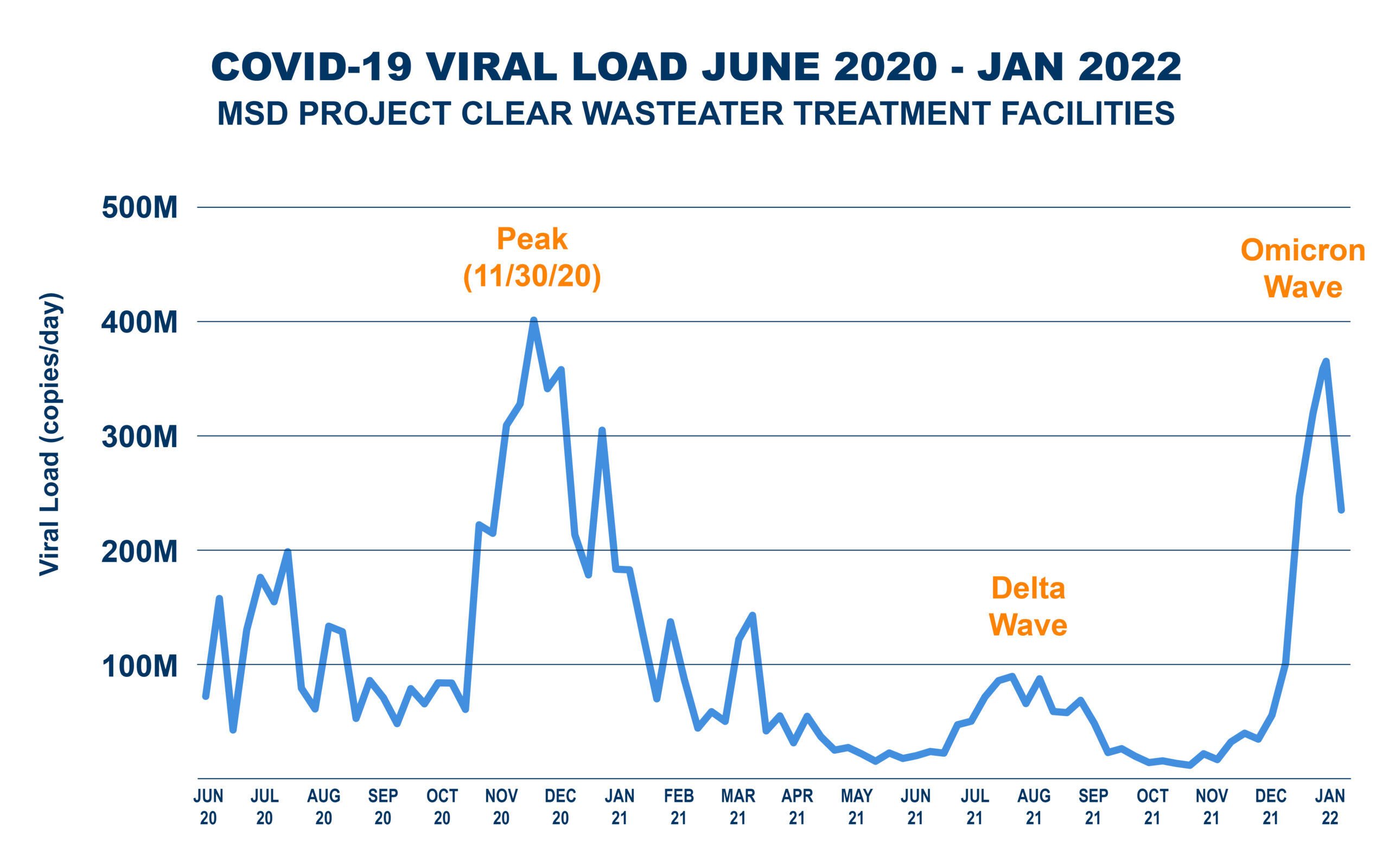New data shows that COVID-19 viral loads in wastewater in the St. Louis community decreased for the first time in six weeks. After reaching a near-record high the previous week, the most recent testing data showed week-over-week COVID-19 viral load levels in the region’s wastewater dropped nearly 36% last week.
The results follow a weeks-long upward trend and are the product of a state and local partnership between MSD Project Clear (MSDPC), which collects wastewater samples at each of its seven treatment plants in the St. Louis region, the Missouri Department of Health and Senior Services (DHSS), which tests the samples in partnership with the University of Missouri (MU), and the Missouri Department of Natural Resources (DNR).
Wastewater testing involves collecting samples from treatment plants, filtering and processing the samples, and measuring trace levels of COVID-19 genetic materials. While this testing detects the presence of COVID-19 genetic material, studies conducted by the University of Missouri-Columbia find that COVID-19 in the wastewater is no longer viable and poses no risk of infection, which is supported by the Centers for Disease Control and Prevention (CDC) having no reported cases of COVID being spread via wastewater.
While it is too early to determine if the omicron variant has reached its peak in the St. Louis region, wastewater testing data can be an important tool in monitoring pandemic trends. Wastewater testing cannot identify infected individuals or the number of people currently infected with COVID, but it is a simple, non-invasive and cost-effective strategy to track the virus’s progression in communities and inform public health strategy.
The chart below demonstrates the recent decrease in COVID detection after the week’s long rise since mid-December. Full data from this project can be found at the DHSS COVID-19 Tracking Tool website, https://health.mo.gov/MOWastewaterCOVID.

“Wastewater testing is now an important tool utilized for the monitoring of the presence of COVID in the community,” said Donald Kauerauf, Director, DHSS. “The genetic material from the virus that causes COVID-19 can be found in wastewater before a community identifies cases through other testing and reporting systems, even when individuals have no symptoms. This testing strategy contributes to the identification of COVID’s presence in the community without relying on the results of individual COVID testing.”
One week of sewershed data showing a decline in COVID-19 levels in wastewater alone is not enough to determine if omicron has reached its peak, but wastewater trends often track with other data sources, including confirmed cases and hospitalizations. Wastewater testing data differ in several ways. It can be a leading indicator, giving public health agencies up to four to six days of lead time for infection rate data, since the presence of COVID can be detected in the waste of asymptomatic and presymptomatic virus carriers. It also offers a more comprehensive picture of COVID-19 cases throughout the community because it does not rely on individual testing data. Nearly everyone uses sewers regardless of their zip code or their access to testing and healthcare.
All partnership members noted that leadership at the state and local levels has been key to making this project successful. Missouri was one of the first states to initiate this type of testing in May 2020, and this is one of the largest-scale projects in the U.S.
“Beyond helping us to understand the extent of Omicron today, this testing program will continue to be an important early detection tool for the presence and extent of future variants in Missouri if and when they arrive, thus resulting in a quicker response to protect citizens,” Kauerauf said.
“Weekly wastewater sample collection was already part of our existing protocols. Providing samples to the state to conduct testing was an obvious choice,” said Jay Hoskins, Assistant Director of Engineering, MSD Project Clear. “This collaboration is an example of MSD Project Clear’s public health mission and our commitment to community partnerships.”
In addition to the St. Louis regional efforts, COVID viral load wastewater testing is underway in more than 50 participating community water systems across Missouri.
About MSD Project Clear
MSD Project Clear (MSDPC) is two utilities in one–responsible for nearly 10,000 miles of public wastewater and stormwater sewer systems in the St. Louis region. MSDPC is investing billions of dollars over a generation to improve water quality and minimize wastewater and stormwater issues by monitoring regulatory compliance, planning, designing, and building community rainscaping, system improvements, and an ambitious program of maintenance and repair.
About the Missouri Department of Natural Resources
The Missouri Department of Natural Resources protects our air, land, water, and mineral resources; preserves our unique natural and historic places; and provides recreational and learning opportunities; while promoting the environmentally sound and energy-efficient operations of businesses, communities, agriculture, and industry for the benefit of all Missourians.
About the Missouri Department of Health and Senior Services
The department seeks to be the leader in protecting health and keeping people safe. More information about DHSS can be found at health.mo.gov or find us on Facebook and Twitter @HealthyLivingMo.

